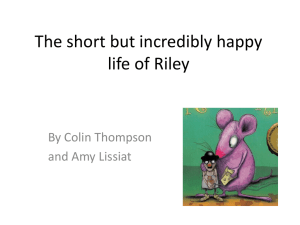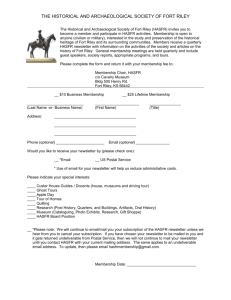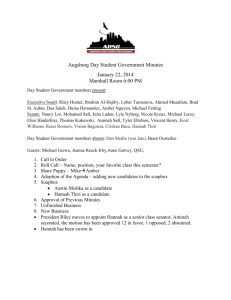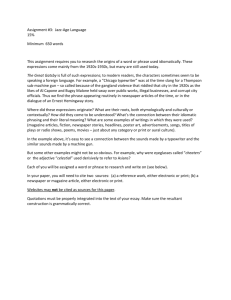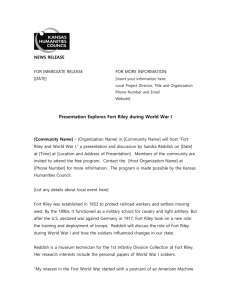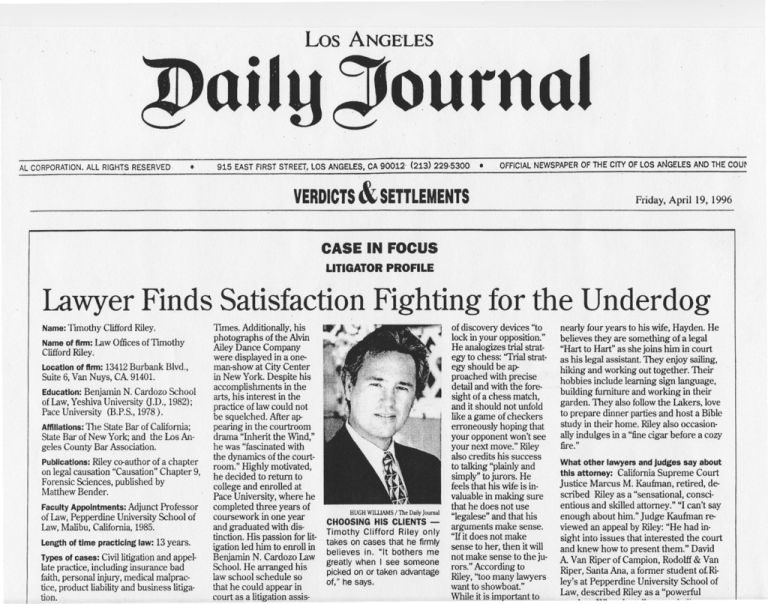
Los
ANGELES
ournaJ
aily
AL CORPORATION. ALL RIGHTS RESERVED
•
915 EAST FIRST STREET, LOS ANGELES, CA 90012-
VERDICTS
(213) 229·5300
•
OFFICIAL NEWSPAPER OF THE CITY OF LOS ANGELES AND THE COU~
& SETTLEMENTS
Friday, April 19, 1996
CASE IN FOCUS
LITIGATOR PROFILE
Lawyer Finds Satisfaction Fighting for the Underdog
Name: Timothy Clifford Riley.
Name of flnn: Law Offices of TImothy
Clifford Riley.
location of flnn: 13412 Burbank Blvd.,
Suite 6, Van Nuys, CA 91401.
Education: Benjamin N. Cardozo School
of Law, Yeshiva University a.D., 1982);
Pace University (B.P.S., 1978).
Affiliations:The State Bar of California;
State Bar of New York; and the Los Angeles County Bar Association.
Publications: Riley co-author of a chapter
on legal causation "Causation" Chapter 9,
Forensic Sciences, published by
Matthew Bender.
Faculty Appointments: Adjunct Professor
of Law, Pepperdine University School of
Law, Malibu, California, 1985.
Length of time practicing law: 13 years.
Types of cases: Civil litigation and appellate practice, including insurance bad
faith, personal injury, medical malpractice, product liability and business litigation.
Times. Additionally, his
photographs of the Alvin
Ailey Dance Company
were displayed in a oneman-show at City Center
in New York. Despite his
accomplishments in the
arts, his interest in the
practice of law could not
be squelched. After appearing in the courtroom
drama "Inherit the Wind,"
he was "fascinated with
the dynamics of the courtroom." Highly motivated,
he decided to return to
college and enrolled at
Pace University, where he
completed three years of
HUGH WIlliAMS I The Daily Journal
coursework in one year
CHOOSING HIS CLIENTS and graduated with disTimothy Clifford Riley only
tinction. His passion for littakes on cases that he firmly
igation led him to enroll in
Benjamin N. Cardozo Law believes in. "It bothers me
greatly when I see someone
School. He arranged his
picked on or taken advantage
law school schedule so
of," he says.
that he could appear in
court as a litigation assis-
of discovery devices "to
lock in your opposition."
He analogizes trial strategy to chess: "Trial strategy should be approached with precise
detail and with the foresight of a chess match,
and it should not unfold
like a game of checkers
erroneously hoping that
your opponent won't see
your next move." Riley
also credits his success
to talking "plainly and
simply" to jurors. He
feels that his wife is invaluable in making sure
that he does not use
"legalese" and that his
arguments make sense.
"If it does not make
sense to her, then it will
not make sense to the jurors." According to
Riley, "too many lawyers
want to showboat."
While it is important to
nearly four years to his wife, Hayden. He
believes they are something of a legal
"Hart to Hart" as she joins him in court
as his legal assistant. They enjoy sailing,
hiking and working out together. Their
hobbies include learning sign language,
building furniture and working in their
garden. They also follow the Lakers, love
to prepare dinner parties and host a Bible
study in their home. Riley also occasionally indulges in a "fine cigar before a cozy
fire."
What other lawyers and Judges say about
this attorney: California Supreme Court
Justice Marcus M. Kaufman, retired, described Riley as a "sensational, conscientious and skilled attorney." "I can't say
enough about him." Judge Kaufman reviewed an appeal by Riley: "He had insight into issues that interested the court
and knew how to present them." David
A Van Riper of Campion, Rodolff & Van
Riper, Santa Ana, a former student of Riley's at Pepperdine University School of
Law, described Riley as a "powerful
11
••
1111
•••••••
Background: Riley was born and raised in
a very small town in Connecticut. The
town was so small that everyone seemed
to be a relative or an in-law, and he grew
up with "old country" family values and
traditions. As a high school student, he
was scouted as a baseball pitching
prospect. However, much to his father's
dismay, he decided instead to accept a
theater scholarship to the University of
Connecticut. During his freshman year,
he was seen in a theater production and
was asked to join the Hartford Stage
Company. He was cast as a member of
the American Shakespeare Theater and
Academy in Stratford and remained in
the Shakespeare repertory company for
two years, appearing in the Broadway
productions of "Henry V" and "Othello."
He also exercised his creativity through
photography and had his own photography studio. He photographed top models
and celebrities such as Bette Midler,
Donna Summer and the Bee Gees, and
his prints appeared in Glamour, Harper's
Bazaar, Rolling Stone and the New York
tant to Herman B. Glaser, the dean of
continuing education for New York State
Trial Lawyers. Although he enjoyed
working for Glaser during his three years
of law school, he declined Glaser's offer
to join his firm after graduation and
moved to California. His first legal job
was with a plaintiffs personal injury firm.
After approximately two years, he started
his own firm. Riley's practice is plaintiff
oriented. He explained that his father
was paralyzed as a child in a hit-and-run
accident and he witnessed how dramatically his father's life was affected by his
injury. He believes that this is the reason
why he always "fights for the underdog"
and it bothers him greatly when he sees
"someone picked on or taken advantage of."
Keys to success: Riley stated, "To be effective, you really have to be prepared"
and "preparation begins with the client
interview." "If you don't like your potential client, the chances are a jury won't either." He takes on only cases and clients
that he firmly believes in. Riley maintains
it is important to take full advantage
a
••..•••••
~
.•.•••••.•••••
t'''' .• '-4.+1."
"V
present the case in an interesting way so
as not to lose the jury's attention, a suecessfullawyer does it with "style and dignity." Riley feels that "honesty must run
through everything" and that the lawyer's
job is to "tell a story without story telling."
Favorite trial moment: Riley's favorite
moment occurred in 1985, during his
first trial in California. He was plaintiffs'
co-counsel in a medical malpractice
wrongful death suit. The decedent was a
63-year-old deaf-mute, who was survived
by his wife and five children. During deliberations, the jury submitted a question to the trial judge. "Usually, trial
counsel tend to get very curious and
concerned whenever the bailiff informs
them that the jury has a problem and
wants to ask the judge a question. My
concern soon turned into a big smile
after the jurors' note was read. The jurors wanted to know if they were limited
in the amount of damages that they
could award the plaintiffs." The plaintiffs
were ultimately awarded $1.9 million.
Personal: Riley has been married for
speaker. When he talks, people listen ...
he is a very credible man." Van Riper
praised Riley as "an excellent professor"
who is able to "simplify difficult and complex concepts. This probably accounts
for [Riley's] success as a trial attorney."
Kenneth A Maranga of Garcia, Emmons, Maranga & Morgenstern has
tried several cases against Riley. He described Riley as being "tenacious." Riley
"never lets up and is always a challenge.
.. When you go up against him you know
he is not going to miss anything." He
also noted that Riley has the "rare ability
in our business to be able to lock horns
with someone and then have an amicable relationship afterwards." Alan Gooding of Pearman & Wilson, Glendale, is a
defense attorney who retained Riley to
handle a personal matter. Gooding was
"very pleased" with the work Riley performed on the case. Riley "is an excellent
trial lawyer ... highly principled, ethical,
charming and articulate." "He's a heck of
a guy and thinks fast on his feet."
THE CASE
Jury Awards $3 Million in Verdict Against Insurance Company
Type: Insurance
law, uninsured motorist claim, punitive damages.
Verdict: $3,060,000 (against Continen-
tal); Defense Verdict in favor of Delores
Nicholson (insurance adjuster).
Case/Number: Patrick and Lou Ann
Crowe v. Continental Insurance Company, et al. / V22577.
Court/date:
Solano Superior / january
12,1996.
Judge: Hon. William Harrison, Dept. 2.
Disbursement: The verdict included
$25,000 each (economic damages for
Patrick and Lou Ann Crowe), $380,000
each (non-economic damages for
Patrick and Lou Ann Crowe) and
$1,125,000 each (punitive damages for
Patrick and Lou Ann Crowe) with a 12%
comparative negligence reduction in the
economic and non-economic damages
recoverable by Patrick Crowe for a net
to him of $1,481.400 and a net to Lou
Ann Crowe of $1,530,000.
Plaintiffs - Timothy Clifford
Riley (Law Offices of Timothy Clifford
Riley, Van Nuys). Defendants - L.
Thomas Wagner (Hardy, Erich, Brown
& Wilson, Sacramento) for Continental
(liability phase); Robert M. Peterson
(Long & Levit, San Francisco) for Continental (punitive damages phase);
Richard Edson (Edson & Laplante,
Sacramento) for Delores Nicholson.
Attorneys:
Plaintiffs - Alan Paul
Gooding, Esq., insurance industry &
claims handling expert, Glendale; Raymond G. Schultz, Ph.D., economist,
Pasadena. Defendants - Vincent Anderson, claims handling expert, San Francisco; John Dugan Barr, Esq., insurance
industry expert. Redding.
Technical experts:
Medical experts: Plaintiffs - James
Moore, Ph.D., psychologist, Vallejo.
Facts: In August of 1985, the plaintiff,
Patrick Crowe, and his IOyear-old son,
Bryan, were broad sided by an uninsured motorist while making a left hand
turn on a green arrow. (The uninsured
motorist was subsequently convicted of
vehicular manslaughter for the wrongful
death of Bryan Crowe.) Patrick Crowe
submitted an uninsured motorist
("UM") claim to the defendants, Underwriter's Adjusting Company and Continental Insurance Company ("Continental"). The plaintiffs, Patrick and Lou
Ann Crowe, claimed wrongful death of
their son. Patrick Crowe claimed personal injury and made a Dillon v. Legg
claim. Lou Ann Crowe claimed loss of
consortium. The defendants' claim file
substantiated that they had determined
liability was 100%clear and rested with
the UM within approximately one
month of Bryan Crowe's death. The defendants made their first offer of settlement approximately sixteen- months
later on December II, 1986. The
Crowe's UM coverage was for $300,000
but the defendants offered $25.000 cash
up-front and a structured annuity which
would payout over 25 years at a cost to
the defendants of $27,000. The defendants offered the plaintiffs $52,000 (present value) total for the wrongful death
of their minor child. The defendants'
claim file substantiated that the comparison jury verdict values were as high as
$1,200,000, including seven other verdicts in excess of the $300.000 policy
limits. The plaintiffs brought this action
against the defendants based on breach
of the covenant of good faith and fair
dealing and intentional infliction of emotional distress theories of recovery.
Continuedon next page

